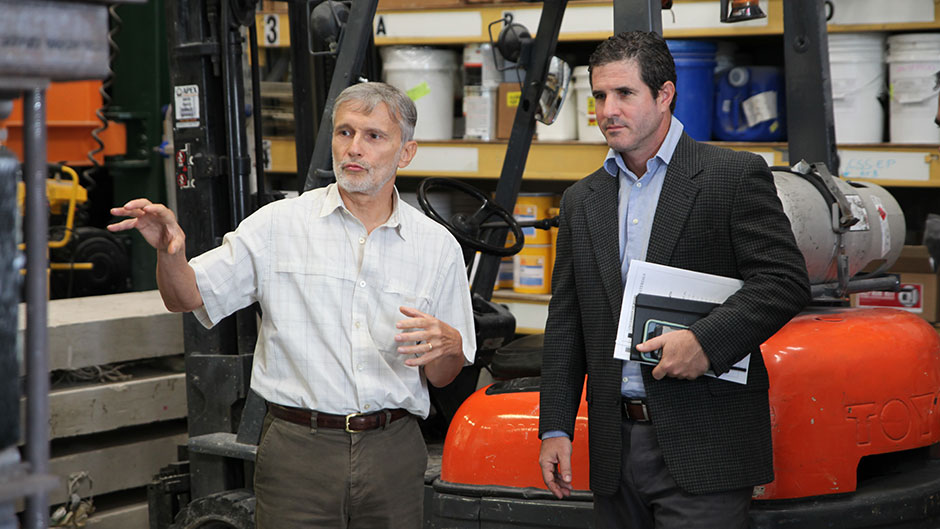North Bay Village, like many other areas across Florida, is beginning to notice the effects of rising sea levels. The community of three islands sits squarely in the middle of Biscayne Bay along the Kennedy (79th Street) Causeway. It was built using excavated fill during the 1940s, and rising waters now threaten its very existence.
The tiny city of about 8,000 people is now looking for lasting solutions.
On Thursday, North Bay Village Mayor Brent Latham, along with village manager Ralph Rosado, public works director Jose Olivo, sustainability and resilience task force chair Denise O'Brien, and Katherine Hagemann, Miami-Dade County resilience program manager, met with University of Miami professors at the College of Engineering to learn about ways to repair the city’s aging seawalls, along with research on other inevitable impacts of climate change.
“We feel that North Bay Village is an ideal laboratory as far as what humans will do to adapt to climate change,” Latham said. “Miami is often used as an example of what could go wrong with climate change, and I would like us to be an example of what could feasibly go right.”
After Latham outlined the challenges his community is facing, faculty members expressed their eagerness to work with North Bay Village and the county to tackle climate change issues.
“At the University, we have a mandate to be relevant to our community and we take it very seriously,” said Antonio Nanni, chair of the College of Engineering’s department of civil, architectural and environmental engineering.
Esber Andiroglu and Prannoy Suraneni, both civil and environmental engineering professors, along with economics professor David Kelly, presented designs from their interdisciplinary UM Laboratory for Integrative Knowledge (U-LINK) project, an ongoing initiative of the Roadmap to Our New Century, to look into sustainable coastal structures — such as seawalls, storm water systems and pumping stations. The team has several ideas to improve upon existing seawalls and are now developing multipurpose concrete structures that will not degrade and corrode in saltwater, and that will also attract marine life to improve the water quality. The team is also looking into the use of floating artificial wetlands to help mitigate water pollution and has come up with the idea to use shipping containers as anchors for mangrove islands.
Landolf Rhode-Barbarigos, assistant professor in the civil, architectural, and environmental engineering department, presented ideas from another U-LINK team project to explore environmentally-sound ways to enhance coastal resilience. Toward that goal, the team is evaluating the impact of healthy coral reefs on wave action and storm surge that are intensified by climate change, as well as designing artificial reefs that can be used for shoreline protection. Rhode-Barbarigos also presented work from a National Cooperative Highway Research Program project on the development of an efficient, cost-effective, and eco-friendly seawall system called SEAHIVE. He showed examples of the perforated concrete columns that allow ocean water to flow through them, dissipating wave energy within the system. The team is currently testing the SEAHIVE system with hurricane strength winds and water in the SUrge Structure Atmosphere Interaction (SUSTAIN) Facility at the Rosenstiel School of Marine and Atmospheric Science. Their next step is to test the SEAHIVE in the ocean, he said.
In addition, Nanni said he had a solution that North Bay Village could start implementing right away — the use of glass fiber reinforced polymer (GFRP) bars inside concrete to fortify structures. Nanni encourages the technique because it can help concrete structures last much longer than those built with steel rebar, which corrodes when the concrete surrounding the bars is exposed to saltwater. Recently, Nanni and his students contributed to a project to build one mile of seawall along State Road A1A in the town of Flagler Beach, where parts of the road washed away during Hurricane Matthew in 2016. He said GFRP-reinforced seawall was installed under the beach next to the roadway and when Hurricane Dorian brushed the coastline this year, there was no effect to the road.
“This addresses the issue of durability,” Nanni said. “If you build like this, it can last 100 years.”

